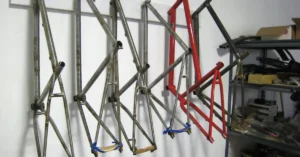The right BMX peg plays a significant role in BMX riding, as it can greatly impact your performance and trick execution.
BMX pegs act as extensions on the bike’s axles, enabling you to balance, grind, and execute various stunts.
There are two popular options in the market: plastic BMX pegs and BMX metal pegs.
Choosing between BMX plastic pegs and metal BMX pegs can be a challenging task because each type has its distinct advantages and disadvantages.
In this guide, we will conduct comprehensive plastic pegs vs metal comparisons based on various factors to assist you in making an informed decision.
Before going into the details of the plastic pegs vs metal pegs comparison. Let’s discuss what is their use.
Table of Contents
ToggleWhat are BMX Pegs for?
BMX pegs, which are small cylindrical attachments extending from the wheel axle, serve a simple yet crucial purpose.
Whether mounted on the front, back, or both sides of the bike, these pegs allow riders to distribute their weight evenly over the wheel.
By placing their feet on the pegs, riders gain a stable and solid platform that enhances bike control during specific maneuvers.
These pegs provide stability and balance, enabling riders to execute movements with precision and confidence.
Whether it’s grinding rails, performing tricks, or executing technical tricks, BMX pegs play a vital role in maximizing bike control and expanding the possibilities of BMX riding.
With BMX pegs bikes become platforms where riders can reveal their skills and unleash their creativity
Now, let’s have a deep understanding of the plastic pegs vs metal pegs comparison.
Related: Are Bike Pegs Universal? Find out here
Plastic BMX Pegs and Metal Pegs Comparison
Plastic Pegs vs Metal: Durability
In terms of durability, let’s examine the comparison between plastic and metal BMX pegs.
Plastic Pegs: Plastic pegs are designed to withstand regular use and offer decent durability.
However, they are more susceptible to wear and tear over time, particularly when exposed to aggressive tricks or heavy impacts. Excessive force can cause plastic pegs to crack or break.
Metal Pegs: On the other hand, metal pegs are renowned for their exceptional durability. They excel in handling intense riding conditions and various tricks.
Metal pegs are less prone to cracking or breaking compared to their plastic counterparts, making them the more resilient choice.

Plastic Pegs vs Metal: Weight
In terms of weight, let’s examine the comparison between plastic and metal BMX pegs.
Plastic Pegs: Plastic pegs offer a significant advantage in terms of weight as they are considerably lighter than metal pegs.
This characteristic is particularly beneficial for riders who prioritize a lightweight setup.
The reduced weight of plastic pegs enables faster spins, enhanced maneuverability, and facilitates easier control during bmx pegs tricks.
Metal Pegs: On the other hand, BMX metal pegs are heavier compared to plastic pegs. This additional weight can have an impact on the overall weight and balance of the bike.
It may affect maneuverability and necessitate greater effort during certain tricks or jumps due to the increased weight of the pegs.
Moreover, Metal pegs’ heavyweight aids riders in maintaining better balance, especially during grinds and tricks that require peg balancing.
The extra weight creates a stable base, reducing the chances of tipping or losing control.
Plastic Pegs vs Metal: Grind Performance
When it comes to grinding performance, there are some notable differences between plastic pegs and metal pegs:
Plastic Pegs: BMX Plastic pegs have a smaller grind surface area.
This smaller surface area can make it slightly more challenging to execute certain grind tricks, as it requires increased precision.
However, some riders appreciate this added challenge and prefer the unique feel that plastic pegs offer, especially on specific surfaces or in particular riding conditions.
Metal Pegs: In contrast, metal pegs typically feature larger grind surfaces. This larger surface area provides riders with enhanced stability and control during grinding maneuvers.
The increased surface area allows for smoother slides and more consistent grinds across various surfaces.
This can be particularly advantageous for riders who value a solid and reliable platform for their grind tricks.
Plastic Pegs vs Metal: Surface Damage
Plastic Pegs: Plastic pegs are soft compared to metal pegs, resulting in a lower likelihood of causing substantial damage to riding surfaces like skatepark ramps, rails, or ledges.
They are generally more tolerant on surfaces, reducing the risk of scratches, chips, or other forms of surface impact. Additionally, plastic pegs tend to produce less noise during grinding tricks.
Metal Pegs: Metal pegs, especially those with sharp edges, have the potential to cause more noticeable damage to riding surfaces.
They may leave scratches or chips on skate park ramps, rails, or ledges due to their hard material.
Additionally, metal pegs can generate more noise during grinds, which can be a concern for riders who prefer a quieter riding experience or frequent noise-sensitive areas.

Plastic Pegs vs Metal: Cost
Plastic Pegs: Plastic pegs are a cost-effective alternative compared to metal pegs. They provide a budget-friendly option for riders who want to save on expenses or are beginners in the BMX riding scene.
Metal Pegs: Metal pegs typically come at a higher price point than plastic pegs due to the increased costs associated with materials and manufacturing.
Despite the higher investment, metal pegs offer superior durability and performance, making them a worthwhile choice for riders seeking long-term reliability.
Plastic Pegs vs Metal: Size
Plastic pegs and metal pegs are available in various sizes, each with its characteristics. The most common size of BMX pegs is 12mm.
In general, plastic pegs tend to be shorter and have a larger circumference compared to metal pegs.
The reason behind this is that plastic, being a softer material than metal, requires a thicker construction to withstand similar levels of wear and tear.
In contrast, metal pegs are thinner and longer which allows greater flexibility.
What BMX Pegs Should I Buy?
When deciding between plastic and metal BMX pegs, it’s crucial to take into account your personal preferences, riding style, skill level, and budget.
Carefully consider these factors to make an informed decision and determine which features hold the most significance for you.
How to Put on BMX Pegs?
Installation of pegs involves several steps.
- Start by using a wrench or socket to remove the axle nut on the wheel.
- Next, carefully slide the peg onto the axle, ensuring it aligns with the dropouts.
- Once in position, reattach the axle nut and tighten it securely. Repeat these steps for the other wheels.
How to Remove BMX Pegs?
- Prepare your tools, including a 15mm or 18mm deep socket, a wrench, and safety glasses.
- Look for the axle nut, typically situated on the inside of the peg.
- Utilize the deep socket to loosen the axle nut.
- Once the axle nut is loosened, you can effortlessly remove the peg from the axle.

Final Words
In this guide, we have explained the metal vs plastic pegs comparison in detail, which will help you in making your choice.
When it comes to choosing between BMX plastic pegs and metal pegs, it ultimately comes down to personal preference and individual riding requirements.
By considering your preferences and riding style, you can make an informed decision that aligns with your specific needs on the BMX bike.









